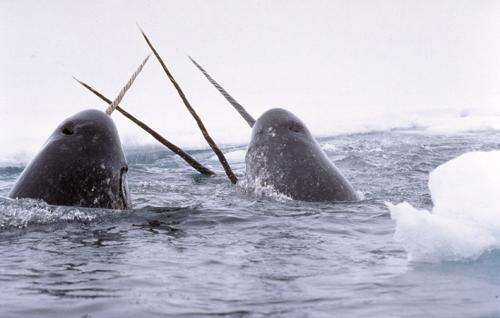March 18, 2014 weblog
Unicorn-like narwhal studied for sensory use of tusks

(Phys.org) —The narwhal is a toothed whale that inspires legend-like notions as the ocean's unicorn and sea warrior, with the male's long tusk that can reach 2.6 m, protruding straight out. While scientists know what the tusk looks like, the questions remain over what the tusk is actually used for. The answers have been difficult to pin down.
The BBC has a detailed look at a recent study published today which seeks to explain more about how the narwhals use their tusk – of interest because the animals are rarely seen, are elusive and in turn difficult to study. The tusk is the left canine tooth that erupts through the upper lip of males. (The World Wildlife Fund said it learns more about the movements of narwhals through satellite tracking. "We document the paths of narwhals during their annual feeding and reproductive routines to better understand the species.")
The study published online Tuesday takes a close look at the tusk which the study's lead author said, in the BBC report, that in the past has inspired a range of suggestions over its use. "People have said it's everything from an ice pick to an acoustic probe."
The new research study published in the journal The Anatomical Record is titled "Sensory ability in the narwhal tooth organ system." The authors sought to understand more about the sensory function and to offer scientific findings. For their investigation, narwhals were captured from land-based camps using an anchored net set perpendicular to the shore, and after capture brought to shore, they said, using standard techniques established for tagging.
The tusk is sensitive to temperature and chemical differences in the external environment. "New evidence presented here indicates that the patent dentinal tubules communicate with open channels through a porous cementum from the ocean environment. The ability of pulpal tissue to react to external stimuli is supported by immunohistochemical detection of neuronal markers in the pulp and gene expression of pulpal sensory nerve tissue."
The scientists suggested the tusk helps the animals sense changes in the environment which the male puts to advantage when looking for females and detecting if they are ready to mate as well as finding food. The authors said, "New findings of sexual foraging divergence documented by stable isotope and fatty acid results add to the discussion of the functional significance of the narwhal tusk. The combined evidence suggests multiple tusk functions may have driven the tooth organ system's evolutionary development and persistence."
The authors observed a link between when the tusk was exposed to different salt levels in water and a corresponding change in the narwhal's heart rate. "Final confirmation of sensory ability is demonstrated by significant changes in heart rate when alternating solutions of high-salt and fresh water are exposed to the external tusk surface."
Lead author Martin Nweeia from the Harvard School of Dental Medicine said in the BBC report that "If you were looking for an ideal and fascinating tooth to study there's no question this would be it."
Further research, according to the BBC, is to focus on traditional knowledge, where hunters in the high Arctic will be asked for their observations. The goal is to learn more about narwhal behavior. Quoted in Wired, Nweeia said that salt is just one of stimuli the tusks could be sensing. "Our premise was just to open the pathway for people understand that this is a sensory organ," he said. "Now the pathway is open for people, including ourselves, to look at other variables it might also detect."
More information: Nweeia, M. T., Eichmiller, F. C., Hauschka, P. V., Donahue, G. A., Orr, J. R., Ferguson, S. H., Watt, C. A., Mead, J. G., Potter, C. W., Dietz, R., Giuseppetti, A. A., Black, S. R., Trachtenberg, A. J. and Kuo, W. P. (2014), Sensory ability in the narwhal tooth organ system. Anat Rec, 297: 599–617. DOI: 10.1002/ar.22886
ABSTRACT
The erupted tusk of the narwhal exhibits sensory ability. The hypothesized sensory pathway begins with ocean water entering through cementum channels to a network of patent dentinal tubules extending from the dentinocementum junction to the inner pulpal wall. Circumpulpal sensory structures then signal pulpal nerves terminating near the base of the tusk. The maxillary division of the fifth cranial nerve then transmits this sensory information to the brain. This sensory pathway was first described in published results of patent dentinal tubules, and evidence from dissection of tusk nerve connection via the maxillary division of the fifth cranial nerve to the brain. New evidence presented here indicates that the patent dentinal tubules communicate with open channels through a porous cementum from the ocean environment. The ability of pulpal tissue to react to external stimuli is supported by immunohistochemical detection of neuronal markers in the pulp and gene expression of pulpal sensory nerve tissue. Final confirmation of sensory ability is demonstrated by significant changes in heart rate when alternating solutions of high-salt and fresh water are exposed to the external tusk surface. Additional supporting information for function includes new observations of dentinal tubule networks evident in unerupted tusks, female erupted tusks, and vestigial teeth. New findings of sexual foraging divergence documented by stable isotope and fatty acid results add to the discussion of the functional significance of the narwhal tusk. The combined evidence suggests multiple tusk functions may have driven the tooth organ system's evolutionary development and persistence.
Journal information: The Anatomical Record
© 2014 Phys.org



















